For the samples collected on August 3, fecal egg counts ranged from 25 to 10850 epg and averaged 1940 ± 1865 epg. The median fecal egg count was 1550 epg.
As compared to two weeks ago, the average FEC was slightly lower (1940 vs. 2100 epg), the standard deviation was significantly lower (1865 vs. 2957 epg), and the median was higher (1550 vs. 1125 epg).
Fifty-eight (58) goats or 62 percent had fecal egg counts above 1000 epg, compared to 50 percent two weeks ago. Thirty-three (33) goats or 35 percent had fecal egg counts above 2000 epg, similar to two weeks ago. 2000 epg is often classified as "clinically significant" for the barber pole worm.
Thirty-one (31) or 33 percent of the goats had egg counts between 2000 and 5000 epg. Four goats had egg counts above 5000 epg, compared to two weeks ago.
A fecal egg count reduction (FECR) was calculated for 6/9 goats which were dewormed on July 21. It varied from -2 to -91%. Evidence continues to support widespread anthelmintic resistance.
Previously, goats requiring deworming were drenched with levamisole + albendazole. Levamisole (Prohibit®) tends to be the most effective dewormer on most goat (and sheep) farms. On August 18, copper oxide wire particles (COWPs) will be used as the second dewormer. Parasitized goats will receive 1 g of COWPs, in addition to levamisole (3 ml concentrated drench per 50 lbs.). Two years ago, COWPs (0.5 g) reduced fecal egg counts by ~82 percent in the test goats.
The fecal egg count of the pooled sample (collected August 3) submitted to the University of Georgia for the DrenchRite assay was 2700 epg. The DrenchRite assay will determine anthelmintic resistance to all dewormers/classes (benzimidazoles + avermectins + moxidectin + and levamisole). It takes about a month to get the results.
Download August 3 Fecal Egg Count Report (revised 8/16/16)
As compared to two weeks ago, the average FEC was slightly lower (1940 vs. 2100 epg), the standard deviation was significantly lower (1865 vs. 2957 epg), and the median was higher (1550 vs. 1125 epg).
Fifty-eight (58) goats or 62 percent had fecal egg counts above 1000 epg, compared to 50 percent two weeks ago. Thirty-three (33) goats or 35 percent had fecal egg counts above 2000 epg, similar to two weeks ago. 2000 epg is often classified as "clinically significant" for the barber pole worm.
Thirty-one (31) or 33 percent of the goats had egg counts between 2000 and 5000 epg. Four goats had egg counts above 5000 epg, compared to two weeks ago.
A fecal egg count reduction (FECR) was calculated for 6/9 goats which were dewormed on July 21. It varied from -2 to -91%. Evidence continues to support widespread anthelmintic resistance.
 |
| Getting a back rub |
Previously, goats requiring deworming were drenched with levamisole + albendazole. Levamisole (Prohibit®) tends to be the most effective dewormer on most goat (and sheep) farms. On August 18, copper oxide wire particles (COWPs) will be used as the second dewormer. Parasitized goats will receive 1 g of COWPs, in addition to levamisole (3 ml concentrated drench per 50 lbs.). Two years ago, COWPs (0.5 g) reduced fecal egg counts by ~82 percent in the test goats.
The fecal egg count of the pooled sample (collected August 3) submitted to the University of Georgia for the DrenchRite assay was 2700 epg. The DrenchRite assay will determine anthelmintic resistance to all dewormers/classes (benzimidazoles + avermectins + moxidectin + and levamisole). It takes about a month to get the results.
Download August 3 Fecal Egg Count Report (revised 8/16/16)












